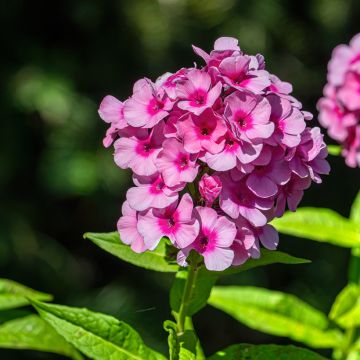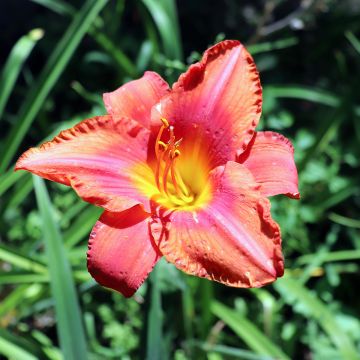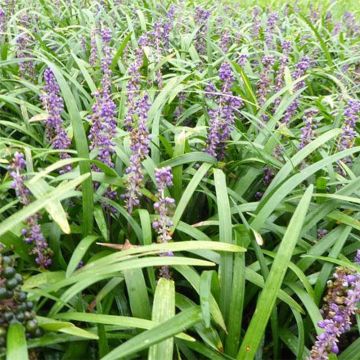

Phlox paniculata Famous Cerise


Phlox paniculata Famous Cerise
Phlox paniculata Famous Cerise
Phlox paniculata Famous Cerise
Garden Phlox, Summer Phlox, Perennial Phlox
This item cannot be shipped to the selected country
Delivery charge from €5.90
More information
Schedule delivery date,
and select date in basket
This plant carries a 12 months recovery warranty
More information
We guarantee the quality of our plants for a full growing cycle, and will replace at our expense any plant that fails to recover under normal climatic and planting conditions.
From €5.90 for pickup delivery and €6.90 for home delivery
Express home delivery from €8.90.

Does this plant fit my garden?
Set up your Plantfit profile →
Description
Phlox paniculata Famous Cerise is a variety of phlox with a compact growth habit, well-branched, highly floriferous in summer, and very resistant to mildew. Throughout the summer, this lovely plant produces particularly colourful flowers, which are a bright cherry-red and pleasantly scented. With its beautiful habit, it makes an excellent variety to place in the foreground of flower beds or in a planter on the patio. Create charming bouquets with its long-lasting flowers that last well in a vase.
Phlox paniculata Famous Cerise belongs to the Polemoniaceae family. It is one of the latest additions to the excellent Famous series, developed in the Netherlands. It is a perennial plant with a woody base forming a dense, rounded clump composed of leafy stems. This variety will not exceed 50 cm (20in) in height and 40 cm (16in) in width. The stiff and sturdy stems are covered with dark green leaves, measuring 10-12 cm (4-5in) in length. The flowering period, longer than that of most tall phlox, begins in July and continues until September, provided that faded flowers are regularly removed. The red-coloured buds open into small tubular flowers, which are a bright pink-red colour, with a discreet reddish-violet throats. They are grouped at the end of sturdy stems that do not bend under the weight of the flowers. These are gathered in erect, dense, pyramid-shaped panicles, 15 cm (6in) in length, and pleasantly scented. The flowering is attractive to bees and butterflies. The above-ground, deciduous vegetation disappears in winter and regrows in spring.
Phlox paniculata are perennial plants commonly found in cottage gardens, as their legendary simplicity and generosity are almost unmatched in perennial flower beds. The varieties in the Famous series add disease resistance, a beautiful habit, and excellent performance in flower beds to all these qualities. The Phlox Famous Cerise can be combined with its siblings from the Famous series (Coral, Purple, Pink, Purple, White, Pink Dark Eye...), with dwarf asters, with white or pink lilies, with the intensely blue perennial flax, or with annual lobelias with which it forms a very cheerful ensemble. Phlox paniculata ''Famous Cerise'' is a top-quality perennial for flowering containers that will adorn balconies and patios.
Report an error about the product description
Phlox paniculata Famous Cerise in pictures




Flowering
Foliage
Plant habit
Botanical data
Phlox
paniculata
Famous Cerise
Polemoniaceae
Garden Phlox, Summer Phlox, Perennial Phlox
Cultivar or hybrid
Other Phlox
Planting and care
Phlox paniculata are easy plants to grow in ordinary soil that does not dry out. Phlox Famous Cerise prefers a damp and rich soil, even clay soils which are well-drained. It needs sun to flower well. A too dry or too hot environment, as well as too much water on the leaves, makes the foliage more susceptible to powdery mildew. Planted in the sun in a climate with hot summers, it will require regular watering and mulching at the base. Pruning faded inflorescences promotes a second flowering at the end of the season. Protect young plants from slugs, which are fond of their tender shoots.
Planting period
Intended location
Care
-
, onOrder confirmed
Reply from on Promesse de fleurs
Summer flowering perennials
Haven't found what you were looking for?
Hardiness is the lowest winter temperature a plant can endure without suffering serious damage or even dying. However, hardiness is affected by location (a sheltered area, such as a patio), protection (winter cover) and soil type (hardiness is improved by well-drained soil).

Photo Sharing Terms & Conditions
In order to encourage gardeners to interact and share their experiences, Promesse de fleurs offers various media enabling content to be uploaded onto its Site - in particular via the ‘Photo sharing’ module.
The User agrees to refrain from:
- Posting any content that is illegal, prejudicial, insulting, racist, inciteful to hatred, revisionist, contrary to public decency, that infringes on privacy or on the privacy rights of third parties, in particular the publicity rights of persons and goods, intellectual property rights, or the right to privacy.
- Submitting content on behalf of a third party;
- Impersonate the identity of a third party and/or publish any personal information about a third party;
In general, the User undertakes to refrain from any unethical behaviour.
All Content (in particular text, comments, files, images, photos, videos, creative works, etc.), which may be subject to property or intellectual property rights, image or other private rights, shall remain the property of the User, subject to the limited rights granted by the terms of the licence granted by Promesse de fleurs as stated below. Users are at liberty to publish or not to publish such Content on the Site, notably via the ‘Photo Sharing’ facility, and accept that this Content shall be made public and freely accessible, notably on the Internet.
Users further acknowledge, undertake to have ,and guarantee that they hold all necessary rights and permissions to publish such material on the Site, in particular with regard to the legislation in force pertaining to any privacy, property, intellectual property, image, or contractual rights, or rights of any other nature. By publishing such Content on the Site, Users acknowledge accepting full liability as publishers of the Content within the meaning of the law, and grant Promesse de fleurs, free of charge, an inclusive, worldwide licence for the said Content for the entire duration of its publication, including all reproduction, representation, up/downloading, displaying, performing, transmission, and storage rights.
Users also grant permission for their name to be linked to the Content and accept that this link may not always be made available.
By engaging in posting material, Users consent to their Content becoming automatically accessible on the Internet, in particular on other sites and/or blogs and/or web pages of the Promesse de fleurs site, including in particular social pages and the Promesse de fleurs catalogue.
Users may secure the removal of entrusted content free of charge by issuing a simple request via our contact form.
The flowering period indicated on our website applies to countries and regions located in USDA zone 8 (France, the United Kingdom, Ireland, the Netherlands, etc.)
It will vary according to where you live:
- In zones 9 to 10 (Italy, Spain, Greece, etc.), flowering will occur about 2 to 4 weeks earlier.
- In zones 6 to 7 (Germany, Poland, Slovenia, and lower mountainous regions), flowering will be delayed by 2 to 3 weeks.
- In zone 5 (Central Europe, Scandinavia), blooming will be delayed by 3 to 5 weeks.
In temperate climates, pruning of spring-flowering shrubs (forsythia, spireas, etc.) should be done just after flowering.
Pruning of summer-flowering shrubs (Indian Lilac, Perovskia, etc.) can be done in winter or spring.
In cold regions as well as with frost-sensitive plants, avoid pruning too early when severe frosts may still occur.
The planting period indicated on our website applies to countries and regions located in USDA zone 8 (France, United Kingdom, Ireland, Netherlands).
It will vary according to where you live:
- In Mediterranean zones (Marseille, Madrid, Milan, etc.), autumn and winter are the best planting periods.
- In continental zones (Strasbourg, Munich, Vienna, etc.), delay planting by 2 to 3 weeks in spring and bring it forward by 2 to 4 weeks in autumn.
- In mountainous regions (the Alps, Pyrenees, Carpathians, etc.), it is best to plant in late spring (May-June) or late summer (August-September).
The harvesting period indicated on our website applies to countries and regions in USDA zone 8 (France, England, Ireland, the Netherlands).
In colder areas (Scandinavia, Poland, Austria...) fruit and vegetable harvests are likely to be delayed by 3-4 weeks.
In warmer areas (Italy, Spain, Greece, etc.), harvesting will probably take place earlier, depending on weather conditions.
The sowing periods indicated on our website apply to countries and regions within USDA Zone 8 (France, UK, Ireland, Netherlands).
In colder areas (Scandinavia, Poland, Austria...), delay any outdoor sowing by 3-4 weeks, or sow under glass.
In warmer climes (Italy, Spain, Greece, etc.), bring outdoor sowing forward by a few weeks.
























































